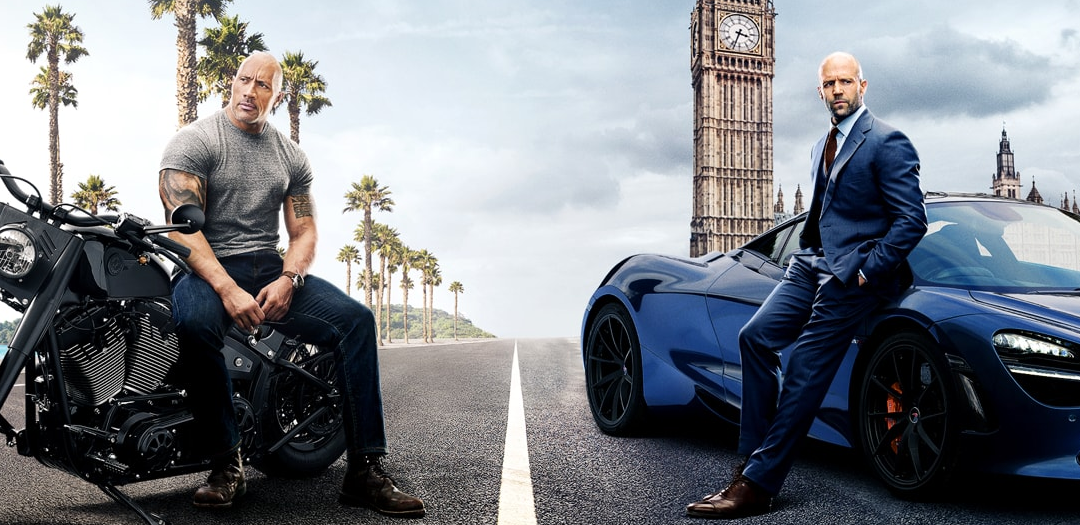“Look at me – I’m black Superman. Idris Elba as Brixton and stating the obvious in Fast & Furious Present: Hobbs & Shaw
“He really is Black Superman.” Dwayne Johnson as Luke Hobbs, agreeing with the obvious.
Early disclaimer: Fast & Furious Present: Hobbs & Shaw is just about everything I’m looking for in a movie. I’ve got nothing wrong with any of it. It will be glorious, and I will be there opening weekend. Now that my biases are on the table, let’s talk some science of stopping people on motorcycles.
Going back to Hobbs’ earlier comment though, oh Hobbs…you’re all supermen. Case in point – okay, there are a lot of cases in point in the trailer to the new movie, but let’s look at the one around the 1:18 mark (scroll to the bottom for the trailer). Hobbs, in a speeding McLaren, punches out the driver’s side window, grabs an oncoming motorcyclist bad guy, holds on to him, and throws him into a stone column as the car passes it.
I don’t want to worry about the punching through the window stuff – given the sound effect, it sounds like it must have been made from something about the thickness of a wine glass. What I want to look at is the whole motorcyclist-interception thing. Speaking in terms of physics, that’s a momentum problem.
Super-fast review, momentum is a property shared by all moving objects and can be calculated by multiplying the mass of the object (in kilograms) by its velocity (in meters per second). It takes force to change an object’s momentum, and as we’ve talked about a few times before, that force is the stuff that would often kill regular people if such things existed in movies, television shows, comics and videogames. To change the momentum in over a very short time, you need a very large force. As I tell my students, that’s a punch. Change momentum over a longer period of time, and you don’t need as large of a force. That’s a push.
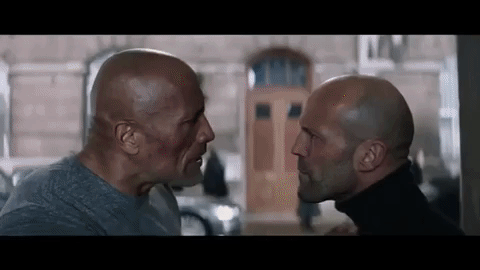
This change in momentum is governed by the momentum-impulse formula:
FΔt = mΔv
FΔt is what’s called the impulse, and its units are in Newton · seconds (it can also go by the letter J)
mΔv is mass multiplied by the change in velocity, which would be a change in momentum since the velocity is changing.
In other words, impulse equals the change in momentum.
To see how the amount of force parts works which I was talking about earlier, solve the above equation for force by dividing both sides by t:
F = mΔv/Δt
From this, you can see that a small value for time will make the force value larger, while a larger value for time will make the force value smaller. It’s why your car has an airbag – to slow your face down as it’s moving towards the steering wheel. The longer it takes, the less force it will take to stop your face (and head) completely.
Okay – that’s almost enough about momentum, but before we start applying physics to Hobbs and Shaw, we need to talk about momentum and collisions. When looking at two or more objects hitting one another, momentum is conserved. That means that the total momentum before the collision must equal the total momentum after. As we like to say in physics class:
(before) (after)
m1v1 + m2v2 = m1v1 + m2v2
The above is for one type of collision, called an elastic collision – hit and bounce. In a perfectly elastic collision, no kinetic energy is lost, and the amounts before and after should equal. If you’re looking at this and you feel your eyebrow going up because the maybe math doesn’t work, that’s because you’re forgetting direction. Momentum is a vector, and therefore can have a negative sign, due to the direction of one of the object’s velocities. In other words, if two objects were coming toward each other, one’s momentum would be positive (usually the one headed to the right), and the other would be negative (usually the one moving to the left). In the physics lab, an elastic collision looks like this:
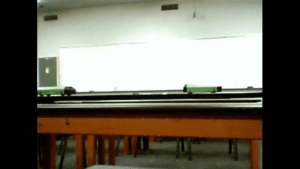
elastic collision
In nature, it looks like this:

Or think of a car crash between a small car and a large truck. The small car will fly away faster while the truck will barely move. That’s because the car’s mass is smaller – its velocity must be larger in order for the momentum to be conserved – and for all the math to work out. It’s why fail videos of two people running towards each other with exercise balls always end like this:

But that’s not what we’ve got going on with Hobbs grabbing the biker. This is an example of an inelastic collision. A weird one, for sure, but still – there’s no bounce. This is a “hit and hug” or a “hit and grab” as my students call it. Again, momentum is conserved, that means that the momentum before has to equal the momentum after, but kinetic energy is not. In this case – in a typical inelastic collision, the “after” is one object (the two objects mashed together) with the mass of both the original objects, combined. The velocity, therefore, has to decrease in order for the conservation to work. Formula-wise, it looks like this:
(before) (after)
m1v1 + m2v2 = (m1+ m2)v2
Again, in a physics lab, an inelastic collision looks like this:
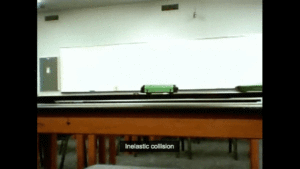
inelastic collision
In the real world – well, look at the trailer. Or think about a car crash where the vehicles stick together due to their mutual deformation. Of train cars that hit and couple together.
For the record, this would be an extreme inelastic collision. The two objects colliding – the biker and Hobbs’ arm – stick together. For a little while at least.
That’s all well and good, but if we want to know what happens to the biker, that means we’re worried about how much force they feel from Hobbs’ arm. For that, we need to talk about impulse. Change in momentum, remember?
As I mentioned earlier:
F = mΔv/Δt
What does the biker experience? Let’s plug in the numbers…
mass – 75 kg; that’s the mass of an average male, which I’m assuming this is. If you assume its a female, shoot for about 60 kg. And let’s note – we’re only talking about the mass for the person, not the person + the mass of the Triumph Speed Triple R they’re riding. The rider comes right off the bike – one part breaks into two.
Δv – the change in velocity. I’m going to assign the car that Hobbs, Shaw and Shaw’s sister are in is moving in the positive direction (yes, I know what I said earlier, but I never want it getting back to Dwayne Johnson that I said anything negative about him. Vector joke). That means out motorcyclist is traveling in the negative direction.
Just from looking at the video, I think the director wants you to think they’re moving a lot faster than they are, so I stayed what I felt was conservative with my numbers: I put the bike at 35 mph (15.65 m/s) and the McLaren 720S that Hobbs is driving at 45 mph (20.12 m/s). As always – if you feel that’s too high or low, alter accordingly.
For the biker then, initial velocity was -15.65 m/s (the negative sign indicates direction), and the final velocity was 20.12 m/s. The car didn’t appear to slow at all, and I’m going to go with the idea that Hobbs knows a little physics and knew that by adding to his mass, his velocity would decrease, so he hit the gas at the moment of impact to keep his velocity constant.
Δv = vfinal – vinitial, so:
Δv = 20.12 m/s – (-15.65 m/s)
Δv = 35.77 m/s
Δt = 0.1 seconds, a typical, acceptable time for an impact that is often used in physics. This is just the time of that hit from which Hobbs holds on to the biker, not the whole trip. It was in that 0.1 seconds that the biker’s momentum changed. Think it was less, decrease that time. The biker will not appreciate it, though.
Let’s get to the last maths:
F = mΔv/Δt
F = (75)(35.77)/0.1
F = 26,827.5 Newtons, or
F = 6031.1 pounds of force.
Yeah, hang on, we’ll get to Hobbs’ arm in a minute.
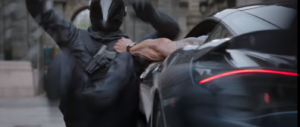
Look at that arm. (c) Universal
That force was delivered across a hand-shaped area, since Hobbs grabbed the biker, rather than just blocking him with his arm. Now we’re talking pressure, or:
Pressure = force/area
In this case, let’s say the area we’re talking is about 12 cm x 14 cm (mine is 11 cm x 12 cm, and Johnson is a lot bigger than me). Change that to meters and we get 0.02 m2. So…
Pressure = 26,827.5/0.02
Pressure = 1.34 x 106 pascals, or
Pressure = 194.3 pounds per square inch (psi)
That’s like 13 atmospheres of pressure in that one spot. It’s a little over twice as much force as an elephant stepping on your chest.
Okay, this is overkill. Let’s talk about damage. A quick punch of around 3,000 Newtons has a 25% chance of breaking a rib, according to biomedical engineer Cindy Bir at Wayne State University in Detroit. And given that the impact looks to be right above the biker’s heart, this is a recipe for all kinds of internal injuries to the cardiac region, and honestly, probably death, as the heart isn’t made to handle that kind of force. Neither is the human body. Most likely, Hobbs’ stopping the motorcyclist broke the rider’s ribs which then went into their heart. The end of the sequence – where Hobbs’ throws the rider so they hit the column? Most likely overkill, since the rider was probably already dead.
Or, if we want to play some more…our 75 kg rider was traveling at 20.12 m/s initially and suddenly – let’s say in 0.1 seconds, again – came to a stop. From our last maths:
F= (75)(-20.12)/0.1
F = -15,090 Newtons of force delivered to the cyclist by the column or,
F = 3,392 pounds force
Or simpler – it’s like being slammed into a stone column at 45 mph.
Let’s go back for a minute and talk about Hobbs’ shoulder. Newton’s 3rd Law says that since he applied 26,827.5 Newtons of force to the rider, the rider applied 26,827.5 Newtons on him. Well, more specifically, through his fist, which is connected to his arm and shoulder, since he straight-armed the rider. Looking at the video again, he didn’t brace his shoulder against the frame of the car, either. His shoulder took all of the force.
That much force pushing the shoulder backward would be more than enough to dislocate it. Badly.
So where are we with the catch-and-release with a motorcyclist? It’s an inspired stunt that’s for sure. Just one more of the reasons why I plan on being in line on August 2nd when Hobbs & Shaw opens. But again – it shows where The Fast and Furious franchise has landed after 18 years and nine movies (with at least three more on the way) – totally stuffed with stunts, totally jacked, and totally superhuman.
Sometimes, I think there are movies that are made just for physics teachers.


